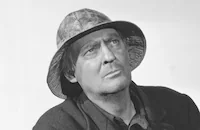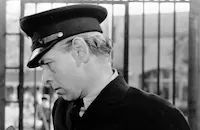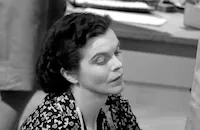Down to the Sea in Ships

Brief Synopsis
Cast & Crew
Henry Hathaway
Richard Widmark
Lionel Barrymore
Dean Stockwell
Cecil Kellaway
Gene Lockhart
Film Details
Technical Specs

Synopsis
In 1887, Captain Bering Joy returns to New Bedford, Massachusetts after a long whaling voyage to find that Jason Briggs and Benjamin Harris, owners of his ship The Pride of Bedford , want him to retire even though he has brought back a record amount of oil. The physically disabled Bering refuses, and afterward, his young grandson Jed, whose father was also a captain and was killed at sea attempting to save one of his crew, leaves his crew in order to continue his formal education. With Bering's help, Jed studies for his fourth grade examination. At the grammar school, superintendent Andrew L. Bush and teacher Miss Hopkins administer the exam, which Jed fails. Bush, who once sailed with Bering and respects him as a great moulder of character, realizes that Bering wants to take Jed to sea again to train him to be a whaling ship master and tells them that Jed has passed. Later, Briggs and Harris introduce Bering to Dan Lunceford, whom they have hired as the new first mate with the intention of having him eventually take over command. Bering is not impressed by the fact that Dan has studied whaling and marine biology at a college instead of learning from direct experience as he has. However, Bering agrees to take Dan on, and The Pride of Bedford sets sail. Bering tells Dan that he is placing him in charge of the crew and that he is to treat Jed like any other crew member but must oversee Jed's studying. Dan tutors Jed but is quite hard on him and gives him menial work assignments. Nevertheless, Jed's studies improve and a mutual affection develops between them. When Slush Tubbs, the ship's cook, suggests to Dan that it is the captain's love for the boy that is driving him on and that he may be becoming jealous of Dan's friendship with Jed, Dan becomes more distant toward Jed. The voyage continues but the crew has no success in locating whales until one day, in South American waters, Jed spots a whale from the crow's nest. Three harpooning boats go out in pursuit, and Dan's boat harpoons the whale and is pulled along by it, but Dan has to cut the line when the harpoonist, Britton, is injured. One of the other boats brings the whale in, and the entire crew renders it. Later, Dan talks with Bering about sending Jed on the next whale capture, and Jed goes out in sailor Thatch's boat. However, by night, a heavy fog has settled in and Thatch's boat has not returned. Although Bering does not want to risk the lives of other crewmembers. Dan goes out with a search boat and finds Thatch, Jed and the crew clinging to the wreakage of their boat and brings them back. The next day, Bering tells Dan that, as a man, he is grateful for what he did but that he violated his authority. Bering then relieves Dan of his duties, telling him that he will be put ashore at the next supply port. Dan accepts Bering's decision, but Jed is dismayed and goes to talk to the captain, "man to man," and requests to be put ashore as well. Thinking he has failed to make Jed the man he hoped he would become, Bering strikes him in anger. Later, as the voyage continues, Bering realizes that he is too ill to continue command and asks Dan to take over. After crewmember Blair examines Bering, Dan decides to take him back to the last port. Dan tells Jed that Bering is a fine man who has made the correct decisions regarding his ship and crew. Later, in thick fog, the ship collides with an iceberg and suffers damage below the water line. While assisting Dan in trying to cover the hole, Britton is crushed between the ship and the ice. Dan rescues him, mangling his arm in the process, but Britton dies. Some of the crew want to abandon ship, but Bering comes on deck and successfully supervises the repairs. On Bering's death bed, Jed withdraws his request to be put ashore and makes up with his grandfather. Bering is buried at sea and Dan respectfully assumes command of the ship.

Director

Henry Hathaway
Cast

Richard Widmark

Lionel Barrymore

Dean Stockwell

Cecil Kellaway

Gene Lockhart

Berry Kroeger

John Mcintire

Henry Morgan

Harry Davenport

Paul Harvey

Jay C. Flippen

Fuzzy Knight

Arthur Hohl

Dorothy Adams
John Northpole
Jimmy Dime
Peter Seal
Robert Dillon
Eddie Das
Minerva Urecal
Jim Hawkins
Crew
Sy Bartlett
Sy Bartlett
Irene Brooks
Frank Cory Jr.
Linda Cross
Ken Darby
Ken Darby
Les Everson
W. D. Flick
Atillio Gabbani
Ben Hayne
Roger Heman
F. E. Johnston
Ray Kellogg
Charles Lemaire
Louis D. Lighton
Louis D. Lighton
Thomas Little
Joe Macdonald
John Lee Mahin
Harry Maret
Cliff Maupin
Cyril J. Mockridge
Alfred Newman
Alfred Newman
Ben Nye
Edward Powell
Walter M. Scott
Fred Sersen
Dick Smith
Dorothy Spencer
Abe Steinberg
Rose Steinberg
Lyle Wheeler
Albert C. Wilvers
Darryl F. Zanuck

Film Details
Technical Specs

Articles
Down to the Sea in Ships (1949)
20th Century-Fox chief Darryl Zanuck had begun pre-production back in 1939, sending second-unit director Otto Brower down to Mexico to shoot extensive footage of whaling operations. Nearly 20,000 feet of that footage was included in the film, although Brower didn't live to see it, having passed away in 1946, two years before production began. The start delays came down to two factors: problems with Sy Bartlett's screenplay and John Lee Mahin's revisions, and the Unites States' entry into World War II in December, 1941. The war placed a damper on all non-essential film production, as clothing and building materials were heavily rationed. Much of Down to the Sea in Ships takes place at sea, but Fox was unable to build a mock-up of a whaling ship in the studio until materials were available. Once restrictions were lifted, director Henry Hathaway and art director Lyle Wheeler built a full-sized replica of the whaler Pride of Bedford. Real whale blubber for the processing scenes was imported from Vancouver Island to lend an air of authenticity.
Although there had been a 1922 silent film called Down to the Sea in Ships, which starred a young Clara Bow, there is no similarity between the two movies, other than the title and the setting of New Bedford, Massachusetts. The 1949 film tells the story of an old whaling captain (Lionel Barrymore) and his grandson, Jed (Dean Stockwell). The ships' insurance company won't cover the next voyage unless Jed can pass an exam proving that he has the education necessary to work on a ship, and that Captain Joy take on first mate Dan Lunceford (Richard Widmark) in case the disabled Joy is unable to lead.
Twelve-year-old Dean Stockwell was born in Hollywood and by 1949, he had been in films like Song of the Thin Man (1947) and The Green Years (1946) at Metro-Goldwyn-Mayer for three years. He was becoming a popular child actor, and his salary had risen to $750 a week when MGM loaned him and Lionel Barrymore out to 20th Century-Fox for Down to the Sea in Ships. Richard Widmark had made a spectacular debut at Fox as a psychopathic killer in Kiss of Death (1947), and the studio had kept him busy for the next two years playing similar roles in no less than four films. Dan Lunceford was Widmark's first good-guy role in film. Widmark's good-guy persona obviously spilled over into real-life, as he became very close to Dean Stockwell on the set. Stockwell, who was not close to his real father, came to regard Widmark as a father figure.
Although Lionel Barrymore had been a star on stage and screen for decades, he had been in a physical decline for over a decade. By the 1940s he was playing most of his roles from a wheelchair and, as director Henry Hathaway learned, the illness seemed to be affecting his memory. Hathaway later remembered that during production, Barrymore was to say a line that included the film's title. He stopped in the middle of the shoot and asked Hathaway what it meant. "I said, 'It's the name of the picture, Down to the Sea in Ships and you can't even remember it.' Oh, I just got so crazy that I went berserk. I said, 'I saw you at lunch. You had a double order of stew and you filled that plate and you don't take any exercise of any kind, you sit in the wheelchair and they wheel you around and put you up on the set and you stand up and say a line. You can't even remember the name of the damn picture.'" Later, when Hathaway was shooting a crucial scene between Stockwell and Barrymore, with Barrymore lying in bed, he ran into another problem. Hathaway's usual method of directing was to speak to the actors and explain what the scene was about and have a discussion, rather than tell the actor what to do. Hathaway walked back and forth, speaking softly because Barrymore was in bed, when Barrymore fell asleep and began to snore. "[Barrymore] came to me later and I said, 'You're not sick, you're just destroying yourself. I mean, you baby yourself.' He had everything wrong with him, most of it in his head." Reportedly, Lionel Barrymore later thanked Hathaway for being tough on him because he felt that he was "simply sitting there, waiting to die."
Because of Barrymore's physical limitations, Hathaway had to use actor and stuntman Richard Talmadge to stand in for him, claiming that it was Talmadge, who resembled Barrymore, had "90 percent of the shots in that picture. [...] His face, everything. He walked like him, he imitated him, and I even had him mouth words in the scenes and had Barrymore sitting on the side talking into the microphone." Ironically, when the film was released in February 1949, the National Council of Rehabilitation gave an award to Barrymore for overcoming a leg injury.
by Lorraine LoBianco

Down to the Sea in Ships (1949)
Quotes
Trivia
Notes
According to documents in the Twentieth Century-Fox Records of the Legal Department and the Twentieth Century-Fox Produced Scripts Collection at the UCLA Arts-Special Collections Library, Down to the Sea in Ships was a project which studio head Darryl F. Zanuck had long wanted to produce. In 1940, Zanuck announced that the studio was producing "three films of the 'road-show' variety...Lillian Russell, Brigham Young and Down to the Sea in Ships." At that time, the studio had acquired an option on the rights to a 1923 film titled Down to the Sea in Ships made by the Whaling Film Corporation of New Bedford, MA. However, the film that was eventually produced by Zanuck was not a remake of the 1923 picture but was based on a new story. October 1940 Hollywood Reporter news items reported that Tyrone Power and Laird Cregar would star and that the studio had sent a crew, headed by James Havens, to Mexico to film whaling operations. However, because of wartime restrictions, the film was shelved for several years. In a September 1945 Hollywood Reporter news item, the studio announced a revival of the project with Power still being considered for the lead. At that time, however, there was no completed screenplay, and writer Sy Bartlett did not become involved in the project until mid-1946. In a February 1948 memo to producer Louis D. Lighton, Zanuck expressed dismay at the length of the 178-page script and proceeded to make radical cuts in it in order to reduce production costs
The majority of the film was shot on one sound stage, in which a full scale reproduction of a whaling ship was built on a hydraulically moveable cradle so that it could be made to sway in front of the sea backgrounds, which were projected on process screens. A few shots were done in waters off Seal Beach, CA but most of the action involving the harpoon boats was done in the studio tank. An April 1949 American Cinematographer article details the shooting of miniatures for the collision of the ship and the iceberg. A studio press release contained in the AMPAS Library files reported that the studio bought four tons of whale blubber from a whaling company in Vancouver, shipped it to the studio in refrigerated trucks and kept it frozen until it was used for the rendering sequence.
Studio records indicate that scenes involving actors Ruth Donnelly, Connie Marshall and Hubert E. Flanagan, as neighbors of Captain Joy in New Bedford, were shot but cut from the film before release. Other legal records list Harry Carter and Bob Adler as members of the ship's crew, but their appearance in the released film has not been confirmed. Studio records also indicate that one of the film's art directors, Ben Hayne, and technical advisor Albert C. Wilvers appeared in the film. Lionel Barrymore and Dean Stockwell were borrowed from M-G-M for this film, which also marked Richard Widmark's first sympathetic role. Widmark appeared at the film's elaborate three-theater, world premiere in New Bedford and rejoined Barrymore for a radio adaptation of the film broadcast on Lux Radio Theatre on April 30, 1951.














